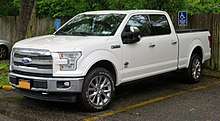Ford F-Series (first generation)
The first-generation of the Ford F-Series is a series of trucks that was produced by Ford in North America from 1947 to 1952. The introduction of the F-Series marked the divergence of Ford car and truck design, developing a chassis intended specifically for truck use.
| First generation | |
|---|---|
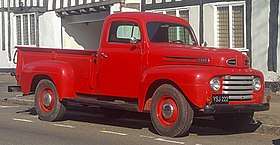 1949 Ford F-3 | |
| Overview | |
| Manufacturer | Ford |
| Also called | Ford Bonus-Built |
| Production | November 27, 1947–1952[1] |
| Model years | 1948–1952 |
| Assembly | Chester, Pennsylvania, USA Dearborn, Michigan, USA Edison, New Jersey, USA Long Beach, California, USA Norfolk , Virginia St. Paul, Minnesota St. Louis, Missouri, USA Hapeville, Georgia, USA Highland Park, Michigan, USA |
| Body and chassis | |
| Class | Full-size pickup truck |
| Body style | 2-door pickup 4-door panel truck |
| Layout | Front engine, rear-wheel drive / four-wheel drive |
| Related | 1946 Mercury M-Series |
| Powertrain | |
| Engine | 226 cu in (3.7 L) I6 239 cu in (3.9 L) Flathead V8 254 cu in (4.2 L) I6 337 cu in (5.5 L) Flathead V8 215 cu in (3.5 L) I6 279 cu in (4.6 L) Y-block V8 317 cu in (5.2 L) Y-block V8 |
| Transmission | 3-speed manual 4-speed manual 5-speed manual |
| Chronology | |
| Predecessor | 1942-1947 Ford pickup |
| Successor | Ford F-Series second generation (1953–1956) |
Across North America, Ford assembled F-Series trucks at sixteen different facilities during its production. In Canada, Lincoln-Mercury sold the F-Series under the Mercury M-Series nameplate to expand coverage in rural areas. The first generation of the F-Series is the sole generation produced entirely with "Flathead" engines (inline-6 and V8).
Design
The first-generation F-Series truck (known as the Ford Bonus-Built) was introduced in late 1947 (going on sale January 16, 1948), replacing Ford trucks introduced in 1941. It had a flat, one-piece windshield and integrated headlamps.[2] It had a wider cab.[2] Options included the "See-Clear" windshield washer (operated by foot plunger), passenger-side windshield wiper & sun visor, and Passenger-side taillight. The F-1 truck was also available with additional stainless steel trim and two horns as an option. All F-series were available with optional "Marmon-Herrington All Wheel Drive" until 1959.
Design of the F-Series truck changed tremendously from 1950 to 1954. From 1948 to 1950, the grill was a series of horizontal bars and the headlights were set into the fenders. For 1951 and 1952, the headlights were connected by a wide aerodynamic cross piece with three similarly aerodynamic supports. The rear window was wider in these later trucks and the dashboard was redesigned. This new cab was called the "Five-Star Cab".
Models
The first-generation F-Series was marketed in eight different chassis (based on their GVWR), giving them their model names; the F-1 was the lightest-capacity version with the F-8 as the highest. F-1 through F-3 pickup trucks were offered (forming the basis for panel trucks) and the bare F-3 chassis served as the basis for a parcel delivery truck. The heavier-duty F-4 chassis was produced as a light-duty commercial truck. The F-5 and F-6 were produced as medium-duty trucks in three configurations, a conventional, a COE/cab-over (as the C-Series), and a school bus chassis (as the B-Series, no bodywork rear of the firewall). The F-7 and F-8 were heavy-duty commercial trucks, marketed under the "Big Job" brand name from 1951.
With the exception of bus chassis and parcel-delivery vehicles (which used bodywork produced by second-party manufacturers), Ford shared the same cab design on all F-Series trucks; C-Series trucks moved the cab upward and forward, requiring a higher hood.
The most common first-generation model was the F-1 with a 6 ½-foot bed, followed by the F-2 and F-3 Express models with an 8-foot (2.4 m) bed.
| 1948-1952 Ford F-Series (Bonus-Built) model range | |||
|---|---|---|---|
| Model | Description | GVWR | Body Style(s) |
| F-1 | ½ ton | 4,700 lb (2,132 kg) | Pickup truck
Panel truck |
| F-2 | ¾ ton | 5,700 lb (2,585 kg) | |
| F-3 | ¾ ton (heavy duty) | 6,800 lb (3,084 kg)
7,000 lb (3,175 kg) (parcel delivery) 7,800 lb (3,538 kg) (optional rear springs) |
Pickup truck
Panel truck Parcel delivery truck |
| F-4 | 1 ton
1¼ ton (optional) |
7,500 lb (3,402 kg)
10,000 lb (4,536 kg) |
Conventional (light-duty) |
| F-5 | 1½ ton | 10,000–14,500 lb (4,536–6,577 kg) | COE (C-Series)
Bus chassis (B-Series) Conventional (medium-duty) |
| F-6 | 2 ton | 14,000–16,000 lb (6,350–7,257 kg) | |
| F-7 | "Big Job" | 17,000–19,000 lb (7,711–8,618 kg) | Conventional (heavy-duty) |
| F-8 | 20,000–22,000 lb (9,072–9,979 kg) | ||
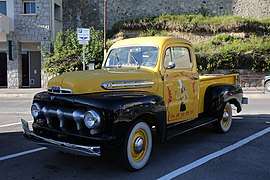 F-1 pickup
F-1 pickup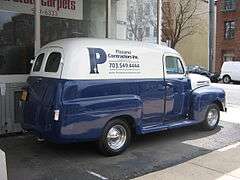 F-1 panel van
F-1 panel van.jpg) F-2 (converted to flatbed)
F-2 (converted to flatbed)- F-4 truck
.jpg) C-6 COE flatbed
C-6 COE flatbed B-6 (bus chassis)
B-6 (bus chassis).jpg) F-6 stake truck
F-6 stake truck- F-7 Big Job fire truck
Variation by Year:
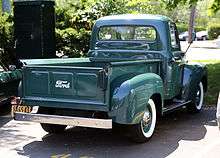
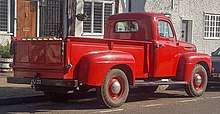
- 1948: Feature a wider, longer, and taller cabs. Model designations for trucks were badged as F-1s. Heater only, No Defroster. Running boards curved over the frame and under the cab.
- 1949: The most noticeable change on the 1949 trucks was the deletion of the red pinstripes on the silver-painted grille bars. Wheels were painted to match body color, rather than the previous black wheels. Defroster added as an option. Running boards trimmed at the frame for ease of replacement. Passenger Taillight became standard as well as Reflectors on both sides.
- 1950: The standard three-speed shift was relocated from the floor to the steering column mid-year. Additionally, the bed lost its structural indents, becoming smooth-sided, and the tailgate chain brackets were now welded to the roll instead of inside it. These changes were kept through 51/52.
- 1951: For 1951, the grille was restyled with a large horizontal bar, moving the headlights further apart, painted either ivory or argent, with either painted or chrome headlight trim; the hood trim was also redesigned. If specified, a V-8 emblem appeared on the front fascia above the grille opening. The truck underwent several revisions, with the cab receiving a larger rear window and updated door panels; for pickup trucks, the tailgate was redesigned, along with the introduction of a hardwood floor.
- 1952: The builder's plate was attached to the inside of the glove box door. While predating a VIN, the information identified the series, model year, assembly plant and production sequence as well as paint code and rear axle gearing.
Powertrain
Engines
| Engine | Years | Power | Usage |
|---|---|---|---|
| 226 cu in (3,700 cm3) Flathead 6 | 1948–51 | 95 hp (71 kW) at 3,300 rpm[3] | F-1 through F-6 |
| 239 cu in (3,920 cm3) Flathead V8 | 1948–52 | 100 hp (75 kW) at 3,800 rpm | F-1 through F-6 |
| 254 cu in (4,160 cm3) Flathead 6 | 1948–51 | 110 hp (82 kW) at 3,400 rpm | F-6 only |
| 337 cu in (5,520 cm3) Flathead V-8 | 1948–51 | 145 hp (108 kW) at 3,600 rpm | F-7 and F-8 |
| 215 cu in (3,520 cm3) OHV Straight-6 | 1952–53 | 101 hp (75 kW) | |
| 279 cu in (4,570 cm3) Lincoln Y-block (EAL) | 1952–55 | 145 hp (108 kW) at 3,800 rpm | F-7 only |
| 317 cu in (5,190 cm3) Lincoln Y-block (EAM) | 1952–55 | 155 hp (116 kW) at 3,900 rpm | F-8 only |
Transmissions
All are manual.
- 3-speed light-duty, F-1 only
- 3-speed heavy-duty, F-1 through F-5
- 4-speed (spur gear), F-1 through F-6
- 4-speed Synchro-Silent, F-4 through F-6
- 5-speed overdrive, F-7 and F-8
- 5-speed direct drive, F-7 and F-8
References
Citations
| Wikimedia Commons has media related to Ford F-Series (1948). |
- Bunn 1998, p. 13.
- Gunnell, John A. (1993). Standard Catalog of American Light-Duty Trucks. krause Publications. ISBN 0-87341-238-9.
- http://oldcarbrochures.org/September%202019/1951%20Ford%20Trucks/slides/1951%20Ford%20Trucks-22.html
Sources
- Bunn, Don (1998). Classic Ford F-Series Pickup Trucks, 1948-1956 (Truck Color History). Truck Color History (1st ed.). Minneapolis: Motorbooks. p. 13. ISBN 978-0760304839.
